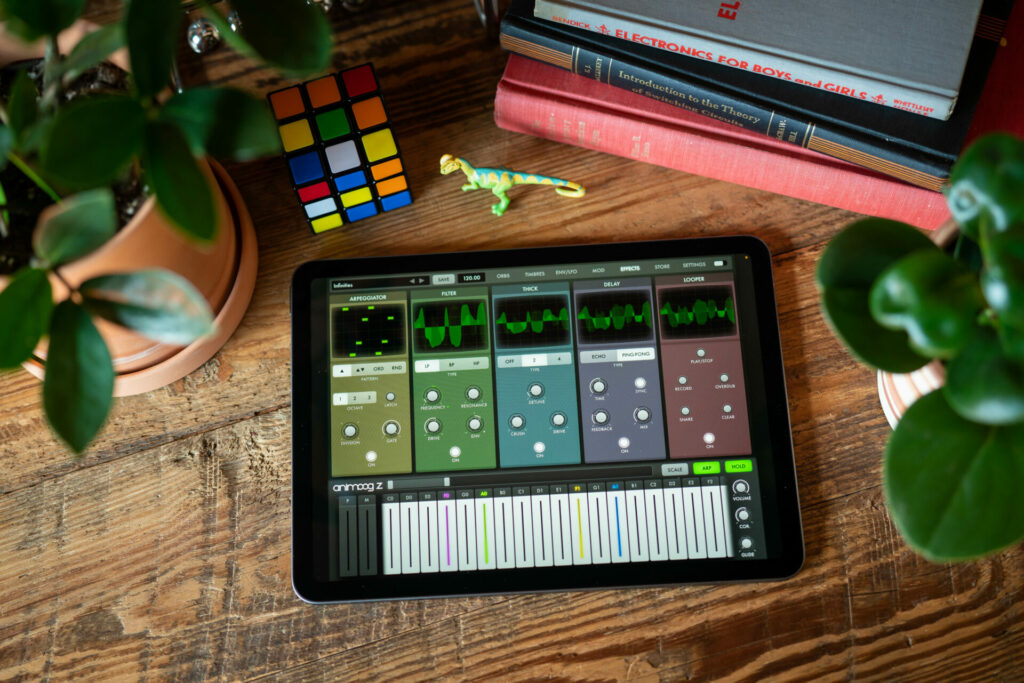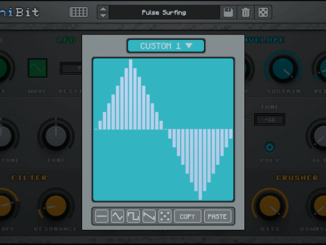Moog intros its Animoog iOS synthesizer into the Z dimension with numerous new inspiring features, a new interface, and as a macOS plugin.
Immediately a sorry for this article which is only partially objective. It has a reason. As a huge fan of Moog’s innovative Animoog Synthesizer app, I was blown away by the news that the development team was working on a successor called Animoog Z. Many have been waiting for a new version with new features. Me too. The app has been part of my jam and live setup for years. For me, it’s an endless inspirational tool.
And today is the day. Animoog Z landed on the Apple AppStore as a universal app for iPad, iPhone, and macOS. Thanks to Moog for giving me the opportunity to beta test the app, and thanks to my Patreon community for making this article possible.

Moog Animoog Z
Animoog Z starts where the original app stopped, but in a completely new form. The core is again powered by Moog’s super expressive Anisotropic synth engine (ASE) that combines wavetables with vector synthesis in a novel orbit system. Now with 16 voices polyphony, with all that lovely, magical polyphonic modulation and pitch shifting from the past. Simply slide your fingers to control multiple per-voice parameters in AZ right from the keys.
The Z in the name of the app, however, has a reason. The developers have extended the ASE engine by the Z-axis. It allows you now to navigate dynamically through the X, Y, and Z axes of sound. This 3D extension alone expands the sound spectrum enormously compared to the previous app.

The engine has also gotten deeper and more customizable. In the original app, timbres could only be loaded through a back door. With the last update, you can import them via Apple’s new file management system. Animoog Z opens the door wide with its own dedicated timbre editor.
Timbres can be imported (.wav files) into this, but you can also record your own with the recording functionality. Simply use the iOS / macOS built-in microphone and the editor will transform your noises or voices into a new wavetable. Yes, the app is made for deep, endless sound design dives.
New Interface
Module sliding is a thing of the past. The Moog developers have given the new version a new redesigned user interface, which is more intuitive and faster. This includes an orbs section that now shows the animation in 3D, a timbre section, env / LFO, a modulation matrix, effects, store, and the settings. On the far left, there is a new patch browser with groups and tags giving you access to the factory library, expansion packs, and your own patches. Also a big step forward.

A Feature Level Up
Animoog Z is not only a visual eye-catcher, the many new features are too. Let’s start with the orbit and path section, which has now become more sophisticated. Thanks to the new Z-axis and new path directions, users can dive even deeper or just rediscover their old sounds in a new way. There are three full-featured envelopes and LFOs.
Each modulator has a little white corner. Once pressed, you can reach the full functionality of the modulator. In this case, the envelope, which extends the feature set of a classic ADSR envelope. It’s a DAHDSR envelope with a loop option, and curve control for the attack, decay, and release. The sample applies to the LFOs, which are also fully customizable.
The center is a new modulation matrix with 10 slots in which modulators can be mapped to parameters and new global destinations like delay, and thick. Plus, you can determine how you want to control the modulation including the mod-wheel, pressure, and more. A little bonus info: the modulation matrix is now modulating at audio-rate making wilder, strange sounds possible. You get a lot of sound design freedom.

Effects
The effects section also got a major makeover. Now reminiscent of the Moog Grandmother and Matriach color layout. It begins with a new arpeggiator that can be started from the orb page and edited in the effects. Animoog and arp? Yes, that fits like a lid on a pot. The Arp lets the sound of the ASE drive in a new direction. And in connection with the polyphonic modulation…, you can get wild, expressive timbres. I can’t get enough of it, especially the random setting that is just awesome.
Then, you a classic ladder filter module, chorus, bit-crusher, and a looper. New oscilloscope-style windows display the output and impact of your effects.
MPE
Full MIDI support is included. That means you can play Animoog Z with an external keyboard or use AZ as a MIDI controller. Like the original app, it sends out MIDI data to external gear. I can only recommend trying it out, it’s a lot of fun. Animoog Z also has MPE support so you can dive deeper into the 3-dimensional synth engine.
MIDI learn is also onboard. The devs upgraded it with the ability to map multiple destinations to a single CC which is a neat addition. Plus, you get program change support.
Important
Animoog has a long iOS history and a huge community (700.000+ downloads). The developers thought of this and optimized the transition to Z with a straightforward preset & timbre import system. So your sounds are not lost in time. Due to the new, upgraded, they will sound a little different. Also, Moog has removed the original version from the AppStore from the sale. Don’t panic, existing users who bought it like me can still download it later.
AZ also comes with Ableton Link, random preset generator, undo/redo functionality, and AUv3 support. A long-awaited feature from the iOS community. And did I already say that Animoog is now also available for macOS?

The Animoog Z Experience On MacOS As A Plugin
For the first time, macOS users can also benefit from the upgraded Animoog Engine. The purchase of Animoog Z includes a macOS version with a dedicated AUv3 and VST3 plugin version. No extra purchase! Everything is in a single bundle (iOS/macOS). The plugin version are a bit wobbly, they still need some maintenance. So you can now host Animoog Z in Ableton Live, Logic Pro… And control it with the iPad or iPhone version, as the app also sends MIDI out to it.
Expansion Packs
Animoog Z also comes with three new great-sounding expansion packs that provide every user with a wide range of new sounds. Fundamental Elements ships with more classically inspired timbres, while Outer Orbits offers clearly more crazy, experimental sounds.
Evolving Oscillations go into the movement. Sounds in which you can observe the expressiveness of the engine very nicely. Here are three in-depth sound demos, each showing sounds from an expansion pack embedded with some technical information.
Suzanne Ciani Performance
One of the most prominent supporters from the very beginning, no not me hehe, is the Synthesizer pioneer Suzanne Ciani aka the Diva of the Diodes. She teamed up with Moog for a fabulous jam where you can see how well Animoog Z harmonizes with hardware equipment. Don’t miss this jam.
One of my greatest Synthesizer wishes came true and that was shortly after my article on my 10th birthday. Animoog Z puts a smile on my face just like the original because the app is fun, sounds extraordinary, and inspires. For another 10 years or maybe more. Thanks, Moog.
Moog Animoog Z is available now as a free download for iOS and macOS. The in-app purchase to unlock the full app engine is available now for an introductory price of $9.99 USD. A single purchase unlocks the engine on all platforms. Individual expansion packs are $4.99 USD. And a VST3 and AUv3 plugin version for macOS users is also out.
More information here: Moog Music




Best news of the year 2021 !!!
Now I would like an affordable MPE keyboard.
That VST wrapper still needs some work. Lots of CPU spikes and hang ups.
yepp, what I wrote: it’s wobbly 🙂
I want to run Animoog Z on Windows. I think this can be done via “Element Modular Plugin Host”, which has been described as a cross-platform VST wrapper. My problem is that I don’t own a Mac and can’t download Animoog Z from the App Store. Is there another way to obtain Animoog Z?
No, there is no Mac to Windows plugin wrapper. Cross-platform means that they are offering the software for mac and windows. Mac software and plugins are different in the code than Windows apps and plugins